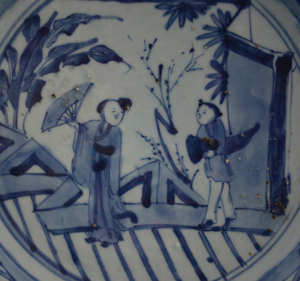
CHONGZHEN 1628 – 1644 Transitional Porcelain
A Large Transitional Blue and White Porcelain Dish, Late Ming, Chongzhen Period 1628-1644. The Octagonal Form, Presumably Based on a Western Metal Form Shows a Scholar with a Fan with His Servant Holding a Qin Set Within a Garden Landscape with Banana, Bamboo and Perhaps Prunus.
SOLD
- Condition
- N/A
- Size
- Diameter : 30 cm (11 3/4 inches)
- Provenance
- N/A
- Stock number
- 24109
- References
- For a Ming Porcelain dish of this form and size with stylistically similar painting but a different design dated to Chongzhen 1630-1640, see : Ming Blue and White Porcelain, The Drs.A.M. Sengers Collection (S.Marchant & Son, November 2001) page 91, plate 66. Another Blue and White Ming Porcelain dish of this type dated Wanli to Tianqi is illustrated in in : Late Ming, Chinese Porcelain from the Butler Collections (Sir Michael Butler, Musee National d`histoire et d`art, Luxembourg 2008. ISBN 978-2-87985-029-0) page 47, plate 20. Provenance : From a Private English Collection of Chinese and Japanese Blue and White Porcelain. Condition: There is a crack to the rim, it is hardly visible from the front and not obvious from the back but it is quite long c.41mm. There are a few small glaze chips. The base is concave and so it doesn't lift flat on a surface. The center of the dish has got some kiln grit.
Information
The Transitional Period :
The roots of this unsettled period starts during the later part of Wanli`s reign (1573-1620). At the begging of his reign China was doing very well, new crops from the Americas such as peanuts, maize and sweet potatoes increased food production, while simplified taxes helped the state run smoothly. But this was not due to Wanli`s enlightened reign, but to his Mother championing a man that was to become the Ming dynasties most able minister, Zhang Zhuzheng (1525—1583). Wanli became resentful of Zhuzheng`s control but upon his death became withdrawn from court life. Between 1589 to 1615 he didn`t appear at imperial audiences, leaving a power vacuum that was filled by squabbling ministers. Mongols from the North raided as Japan invaded Korea. Wanli re-opened the silver mines and imposed new taxes but the money was lost due to corruption, as well as being frittered away by the indulgent Emperor himself . The next emperor of Ming China, Tianqi (1621-1627), was bought up in this self indulgent disorganised environment, at the very young age 15 his short reign started. He didn`t stand a chance. Tianqi made the mistake of entrusting eunuch Wei Zhongxian (1568-1627) who Anna Paludan in her excellent book "Chronicle of the Chinese Emperors" (Thames and Hudson, 1998) describes as "a gangster of the first order". Tianqi was deemed to have lost the Mandate of heaven by the Ming people. Tianqi`s younger brother, the last of the Ming Emperors, Chongzhen (1628-1644), was not able to save the situation. The systems of administration had broken down, corruption was rife and so when a sever famine broke out in 1628 nothing much could be done. Anna Paludan describes the tragic end to the great Ming Dynasty "The final drama was worthy of a Greek tragedy. The emperor called a last council in which `all were silent and many wept`, the imperial troops fled or surrendered, and the emperor, after helping his two sons escape in disguise, got drunk and rushed through the palace ordering the women to kill themselves. The empress and Tianqi`s widow committed suicide; the emperor hacked off the arm of one daughter before killing her sister and the concubines. At dawn he laid his dragon robe aside and dressed in purple and yellow, with one foot bare, climbed the hill behind the now silent palace and hanged himself on a locust tree". The Great Wall of China, started 2,000 years ago was built to protect China from the Northern barbarian hoards, it was often tested and sometimes failed. The Jin people invaded China, ruling the North between 1115 and 1234, it was their descendants the Manchus, Jurchens from south east Manchuria that took full advantage of the problems of the Ming dynasty. In 1636 they adopted a Chinese dynastic name, the `Great Qing` (Qing meaning pure). The first of the Qing emperors was Shunzhi (1644-1661) but for most of his reign his uncle ran the state. War raged on during this period and it wasn`t until the second Qing emperor Kangxi (1662-1722) that true peace was achieved. Kangxi was a wise and educated man, he became a highly successful emperor bringing China a long period of wealth and stability.
Qin or Guqin :
Guqin is the modern name for a plucked seven-string Chinese musical instrument of the zither family. It has been played since ancient times, and has traditionally been favoured by scholars and literati as an instrument of great subtlety and refinement, as highlighted by the quote "a gentleman does not part with his qin or se without good reason," as well as being associated with the ancient Chinese philosopher Confucius. It is sometimes referred to by the Chinese as "the father of Chinese music" or "the instrument of the sages". Traditionally the instrument was called simply qin but by the twentieth century the term had come to be applied to many other musical instruments as well: the yangqin hammered dulcimer, the huqin family of bowed string instruments, and the Western piano are examples of this usage. The prefix "gu-" (meaning "ancient") was later added for clarification. It can also be called qixianqin (lit. "seven-stringed instrument"). The guqin is not to be confused with the guzheng, another Chinese long zither also without frets, but with moveable bridges under each string. Because Robert Hans van Gulik`s famous book about the qin is called The Lore of the Chinese Lute, the guqin is sometimes inaccurately called a lute.



